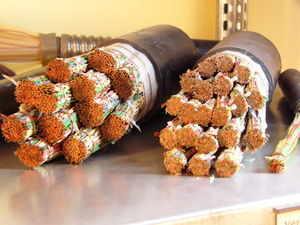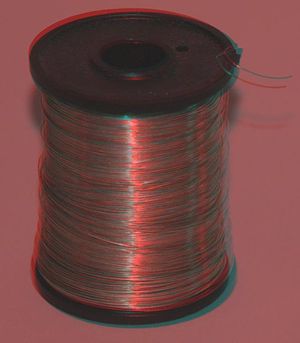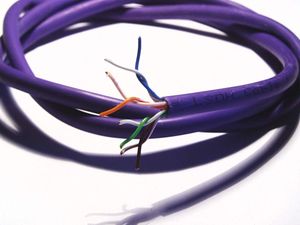Low voltage wiring
This article is about wiring suitable for voltages below 50v.
Terminology
The terminology 'low voltage' or 'LV' to describe these uses is in widespread use, but is not consistent with use of the term 'low voltage' as used in the 16th edition Wiring Regulations. The regs use the term to describe any voltage of 500V or less, thus including normal mains voltage as well as lower voltages. (This makes sense when you use it to distinguish from High Voltage - i.e. the 11kV and higher voltages used in power distribution networks before you get to your local substation, but it is a bit non intuitive in other cases)
Uses of LV Cable
Current Uses
- Computer Networking
- Phones in any room
- Intercoms & Entryphone
- Nightlighting
- Backup lighting
- Burglar alarms
- Interconnected fire alarms
- Security cameras
- TV & satellite aerial feeds
- Remote control
- Radio, music & video distribution
- LV distribution, Wallwart elimination
- Help call systems
Future Uses
Since installed wiring will be in place for decades, who knows what other interconnected or networked apps might become desirable over the decades ahead. Multicore cabling can be expected to enable the majority of them.
One fairly likely candidate in the years ahead is heating that is intelligently controlled room by room to reduce energy use & improve comfort.
Whether each future app will rely on fixed cabling or rf we don't know. However having cabling in place is a way to greatly increase the likelihood that any future app can be used when wanted.
Discussion
Installation
Cost
Installing lower voltage cabling as a standalone project is often disruptive to decor, and consequently expensive.
Installing it at a time when it causes no additional costs is generally a minimal cost exercise. For example 50m of cat5e can be bought for £16, and is enough to enable lots of apps. Redecoration, replastering, extension, remodelling and new build are all cabling opportunities. If such an opportunity is missed and cabling is wanted in future, the extra cost incurred can be 3 or 4 figures.
When labour & cost need to be minimised, consider the option of installing the cable but no connectors. In this case the cable is laid in place and that's it. This way it can easily be put into use at any time in future, but without the hassle or cost today.
Quantity
Cable is very cheap, putting 2 cables in one space costs no extra, and one multicore cable can only be used for so many comms or power lines. Consequently its often recommended to put a few cables in rather than one. Its not hard to use up the cores in 3 cat5 cables, so if you've got more cable you may as well fit it.
Some people are fitting 10s of cat5e cables per room to ensure they will never run out in their lifetime. The photo above of telecoms cable in the Museum für Kommunikation in Hamburg contains 3200 conductors!
Layout
Its hard to idealise cable layout for systems as yet unknown or unchosen. However one layout offers significant advantages, and that is a star shaped central hub layout. Cable from each room comes back to a central point in the house. Advantages include:
- All connections between the different runs of cable are user accessible.
- Enables a much greater number of point to point connections around the house than a ring shaped run
- Cable lengths are minimised for applications that require this. These include hf data links and power distribution.
Outlets
The right connectors will be fitted for immediately wanted apps, such as computer networking, but the connections that will be wanted for later uses can not be known at installation time. A double pattress blanking plate enables almost any connectors to be fitted later, & is standard and easily replaced if need be. It also blends in with the other electrical fittings.
Leave some spare length of cable at every end & connection point to allow for easy working, breakage, movement etc.
Cable Identification
At Fitting
With so many cores and multiple cables its easy to end up not knowing what connects to where. One simple trick will save a fair bit of time later, and that is to use a permanent pen to run a coloured stripe down each cable. Using 3 or 4 colours gives lots of possible colour codes and can save a lot of hassle identifying cables later.
Further distinction between cables can be made with different line patterns: straight, wiggly, thin pen, thick pen, 2 colours, etc.
After Fitting
If confusion occurs after fitting (or should that be when), there are simple ways to work out which is which:
- Feed a pair with a wallwart or battery, locate it at the other end with a torch bulb
- Short a pair together at one end, locate with a multimeter at the other end. A torch can used instead of meter for short cables.
- Where large quantities of cables come to one central hub, feed one end with a 10kHz oscillator and home in on the signal at the other end with a sniffer device consisting of a capacitive plate pickup, very high impedance amplifier & mini speaker or AWD.
Cable Types
- Instrument wire
- Enamelled Copper
- Bell wire
- Speaker wire
- Mains wire
- Cat 5 cable
- Multicore cable
- Co-ax Cable
- Ribbon cable
Singles
Instrument Wire
- Single pvc insulated wire
- Stranded
- Enables any desired number of cores to be used
- Not good for computer networking
- Available in various copper sizes
- Larger sizes suited to power distribution
- A small number can be mixed in with other wire types for LV power distribuion
- Not an wire ideal type, but can be used if you already have a large quantity of such wire.
Enamelled Copper
Where installation with no disruption of decor is necessary, this can be achieved with enamelled copper wire. This unique type of wire has its own set of issues, it can not be treated like pvc cable, but it can be routed almost anywhere, even in some surprising places, while remaining out of sight and not affecting the decorations.
The big advantage is that its ultrathin profile (sizes down to 0.3mm are practical to use) renders it nearly invisible, enabling fitting in all sorts of places pvc cable would not go. Examples are:
- In cracks along corners or up walls
- Along top of skirting
- Tucked under or behind skirting
- Under carpet
- Down corners of walls, covered completely with a thin smear of filler.
- Through cracks & gaps in floors, frames & walls
The disadvantages are:
- Not as robust as pvc cable, and should be kept from any more than occasional user contact for this reason.
- Should not be moved or reused once laid, as the enamel will crack and shorts occur.
- Never re-use enamelled copper wire. Many have tried it, and it rarely works.
- Single core cable only
- Where cores are not spaced from each other they should be completely immobilised to avoid the chance of later shorting. This is easily done in most cases.
- Ends should be terminated to something fixed rather than a flying connector, as it does not like movement.
- Wire can be fixed with a drop of glue.
2 & 3 Core
Bell wire
- Lowest cost 2 core wire.
- Solid core
- 1A rated
- Suitable for most low power low frequency uses, eg:
- intercoms
- bells
- remote control
- low power distribution
- low power speakers (up to 8watts for 8 ohm, 4w for 4 ohm) (that's real watts, not pmpo watts)
Speaker Wire
Stranded flexible 2 core wire, available in a few different copper sizes each with their own current rating.
Multicore
Multicore alarm cable
- For most multicore uses
- Alarms
- Intercoms
- Fire alarm systems
- Most 2 core uses as well
- Low current rating
- Cores can be parallelled to enable power distribution, though ampacity is still limited
Cat5
Uses as multicore cable, plus also good for computer networking
Cat5e has better specs than Cat5, and is the currently recommended networking cable.
Cat5e is recommended for phone extensions now, as these are liable to carry broadband signals, even if they don't already.
Co-ax
High frequency uses required co-ax cable until recently. (Now its possible to stream video over twisted pair.)
It is important to use the right type of co-ax for each app. They are far from all the same.
CAI approved satellite cable is good for all the above apps, so can be used for maximum flexibility.
Cable Choice
Ideal
The perfect LV cable installation would include a mix of cables for all uses.
- CAI approved co-ax for satellite, tv, DAB, FM & baseband video
- Cat5 for computer networking, phone & other multicore apps
- 2.5 T&E or similar for LV power distribution
Low Cost
A good simple low cost option is a few cat5 cables. These are good for
- Computer networking
- Phone
- Nearly all multicore uses
- Low power distribution (parallel cores to increase ampacity)
- And even video distribution with some effort
The average 2 or 3 bed house can be cat5 cabled with £15-30 of cable.
Safety
Shock is not usually a significant risk - although there are special circumstances in which it can be.
Fire risk is an issue. LV wires are perfectly capable of starting fires and LV power supplies should always be suitably fused or otherwise protected.
LV wires should not be permitted to share mains connection boxes, as accidental mains contact could occur due to a stray wire. The Wiring Regs 16th edition also places restrictions on LV cable sharing conduits or channels with mains wires.



